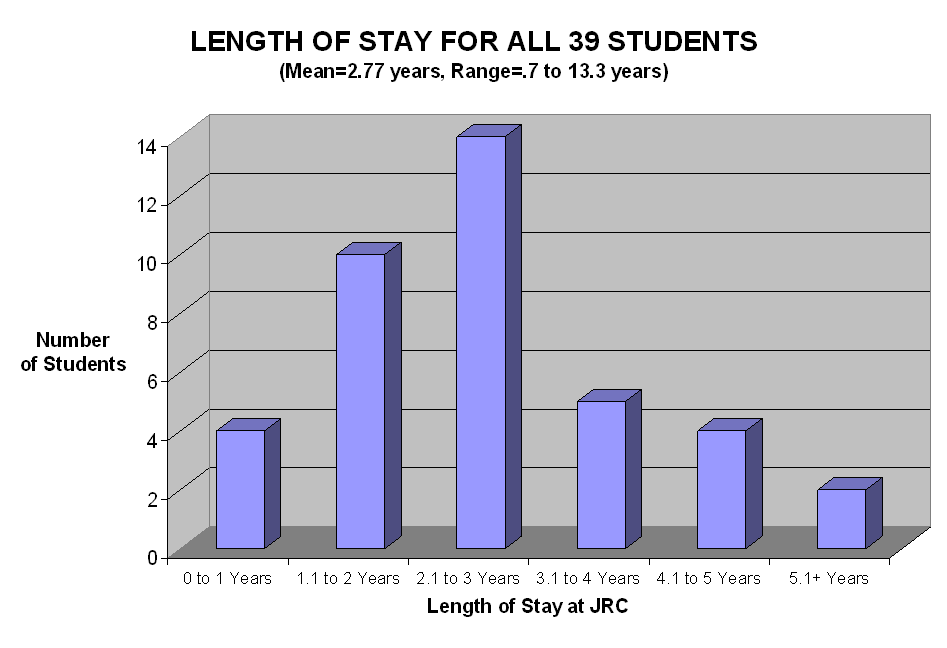
|
Use of Skin-Shock at the Judge Rotenberg Educational Center (JRC) |
Wong, S., von Heyn, R., Israel, M., Assalone, J., & Silva, R.
This study examines the post-treatment outcomes of 39 former students of the Judge Rotenberg Educational Center (JRC), a residential care facility that employs a highly consistent application of behavioral treatment and educational programming. The students were evaluated approximately 1.71 years (range 0.3 to 3.75 years) after leaving JRC, using both a subjective General Life Adjustment rating (obtained from guardians, former students, and JRC staff) and an objective count of certain Quality of Life Indicators. The group of students as a whole showed marked improvement over their status prior to enrolling in JRC on both of the measures employed.
Introduction
Examining post-treatment outcomes of residential care facilities remains an important aspect in assessing the long-term durability of treatment students receive while in the care of the facility and the generalizability of treatment effects to natural environments. The participants in this study consisted of former students of the Judge Rotenberg Educational Center (JRC). JRC operates day and residential programs for children and adults with behavior problems, including conduct disorders, emotional problems, brain injury or psychosis, autism and developmental disabilities. This study is part of JRC’s on-going efforts to assess the effectiveness of treatment after students have left and to find ways to improve the transition process following residential treatment.
The basic approach taken in
all of JRC's programs is the use of behavioral psychology and its various
technological applications, such as behavioral education, programmed
instruction,
precision teaching,
behavior modification, behavior therapy, and behavioral counseling. From JRC's
inception, its basic philosophy has always included the following principles: a
willingness to accept students with the most difficult behavioral problems and a
refusal to reject or expel any student because of the difficulty of his or her
presenting behaviors; the use of a highly structured, consistent application of
behavioral psychology to both the education and treatment of its students; a
minimization of the use of psychotropic medication; and the use of the widest
range of effective behavioral education and treatment procedures available[1].
As a result of JRC’s zero-rejection admissions policy, students who attend JRC
have included some of the most challenging and difficult students in the nation.
Method
Participants
The participants consisted of 39 former students of the Judge Rotenberg Educational Center (JRC). An initial follow-up study was conducted in May 2003 in which there were 31 participants. Participants for this study were selected from a combined pool of the participants from the original study and additional students who left JRC within the intervening year. No limits were established with regard to time since discharge in order to provide the largest possible pool of potential participants. All participants had to have been enrolled at JRC for a minimum of 6 months.
All of the participants had received comprehensive behavioral treatment during their tenure at JRC. For 26 of these former students (66.7%), treatment had consisted of positive-only programming. For 13 of these former students (33.3%), treatment had consisted of positive programming supplemented with contingent aversives in the form of a brief skin shock generated by the Graduated Electronic Decelerator (GED) device[2].
Method
Once potential participants were identified using the selection criteria described above, the legal guardians of the participants (or the participants themselves, if they were their own guardians) were contacted via telephone by JRC staff members. During a telephone interview, the guardians (and/or former students) were asked a set of questions from a structured questionnaire, which included questions regarding dimensions of general life functioning, such as psychiatric hospitalizations, psychotropic medications, legal involvement, day-time activities, and educational activities. Guardians were also asked to provide a general narrative and comments regarding the former students’ performance. Lastly, guardians and former students were asked to provide a rating of their general life adjustment based upon a 5-point Likert-type scale (with 1-very poor, 2-below average/not good, 3-fair, 4-good, and 5-exceptional). These ratings were provided both for present life adjustment and for life adjustment prior to receiving treatment at JRC. Two experienced JRC administrators also provided ratings of the former student’s life adjustment both before treatment at JRC and based upon an evaluation of the former student’s present performance as described by the guardian.
The total group of participants was divided into subgroups determined by level of functioning (cognitively typical versus developmentally-delayed) and alternatively by type of treatment received (positive programming only versus positive programming with supplementary aversives) to determine if there were differential outcomes associated with those variables.
The general life adjustment of participants before and after treatment was further examined using certain quality of life indicators such as “No Psychiatric Hospitalization Required” and “Off Psychotropic Medication” to evaluate how well the students were doing.
Results
From an initial total pool of 58 potential participants, 40 (68.9%) guardians or former students were successfully contacted. In one case, although the guardian was contacted, he no longer was aware of the whereabouts, contact information, or life adjustment of the former student as she had left to live with her other parent. This provided a final pool of 39 participants that were examined in this study. All participants in last year’s study were eligible for this year’s investigation. However, only 22 of the original 31 (70.9%) participants were able to be successfully contacted by JRC staff for this year’s investigation. As with last year’s study, the sole reason for inability to contact was a lack of current contact information despite extensive measures to maintain contact and obtain current contact information (e.g., early mail-outs, repeated phone contacts, searches of information databases such as 411, etc.). In the year between May 2003 and May 2004, 36 additional students left JRC. Out of this potential pool of 36 additional participants, 17 (47.2%) were successfully contacted and able to participate in this year’s study. This was consistent with last year’s successful contact rate of former students or guardians (46.3%).
The mean age of participants (at the time of this investigation) was 22 years with a range of 14.4 to 44.9 years. The mean length of stay at JRC was 2.77 years with a range of .7 to 13.3 years. The mean time since discharge from JRC was 1.71 years with a range of .3 to 3.75 years. See Figures 1.1 and 1.2 for frequency distributions of length of stay and time since discharge.
Figure 1.1

Figure 1.2
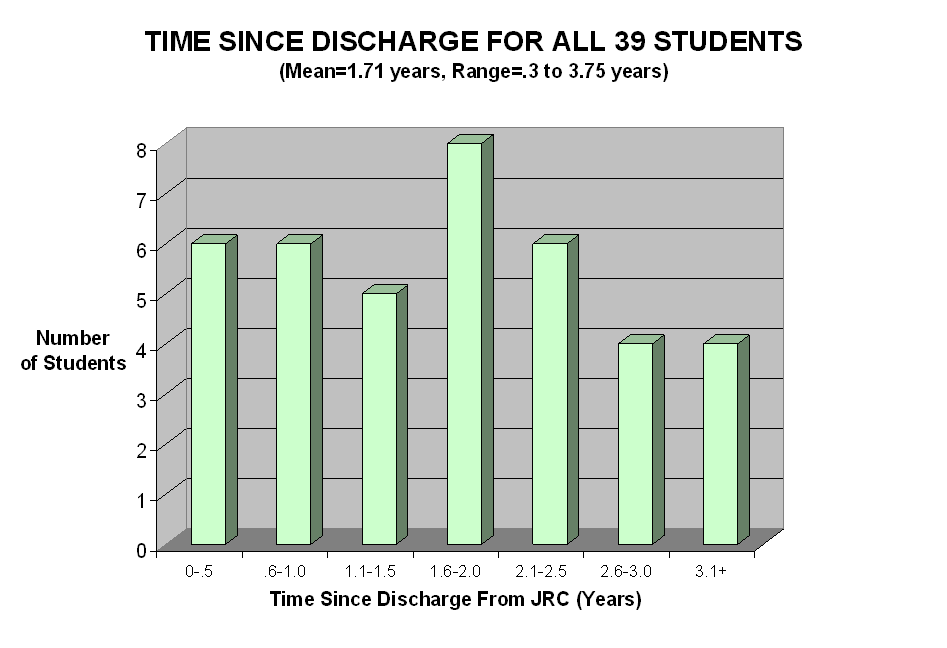
Out of a total of 39 participants, 26 (66.7%) received only positive programming. Thirteen participants (comprising 33.3% of the total) received a combination of positive programming with supplemental aversives. Seven participants (17.9%) were Developmentally-Delayed (Full Scale IQ < 69) while the remaining 27 former students (82.1%) were Cognitively Typical (Full Scale IQ> 70). Pie charts that analyze the participants in terms of type of treatment (Figure 2.1) and level of functioning (Figure 2.2) are provided.
Figure 2.1
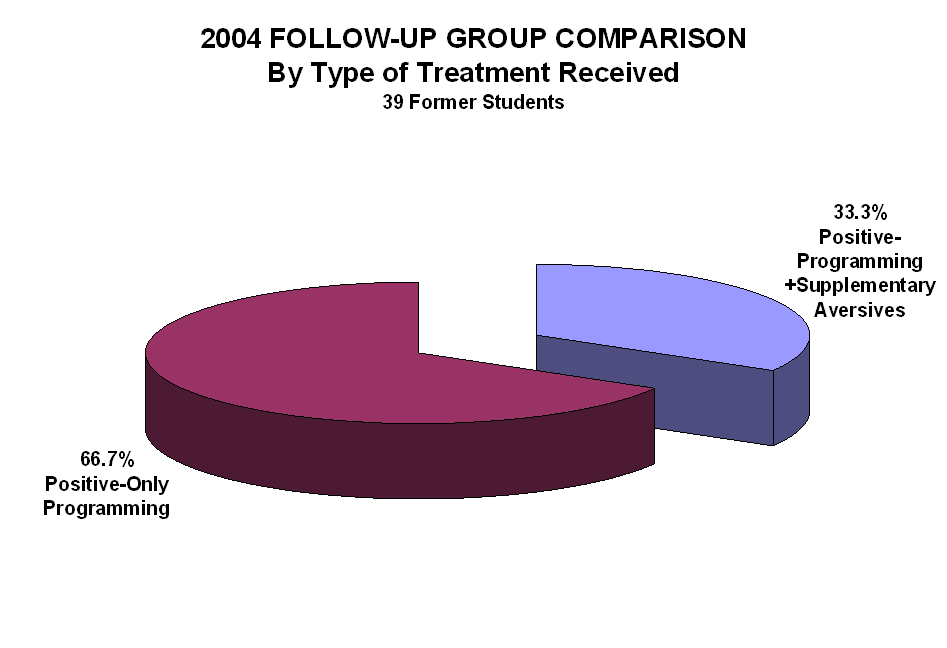
Figure 2.2
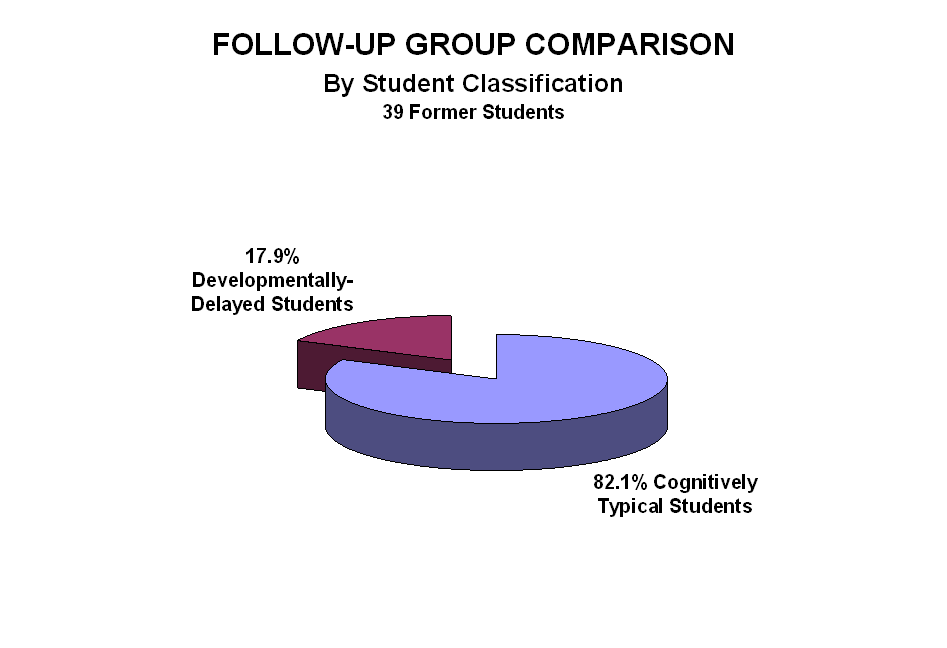
JRC staff ratings of general life adjustment (GLA) were gathered for all students, both before and after treatment. In a change from last year’s study, former students also provided ratings of their own pre- and post-treatment GLA, although this did not occur in all cases due to inability to contact or inability of student to provide this type of information (i.e., due to level of cognitive functioning or non-verbal status).
Additionally, guardians provided the same information in all possible cases. In some cases, only the former students who were their own guardians were reached; correspondingly, there is no guardian rating in those cases. See Table 1 below (and Figures 3.1 and 3.2) for comparisons of before and after JRC composite GLA ratings (averaged across all raters) across type of treatment and level of functioning.
Table 1. Before and After JRC GLA Average Ratings in Different Student Groups
|
|
Groups of Students |
Before JRC |
After JRC |
|
|
All Students (n=39 total participants) |
1.54[3] |
4.14 |
|
Type of Treatment[4] |
Positive-Only Programming (n=26 of 39) |
1.54 |
4.02 |
|
|
Positive Programming + Supplementary Aversives (n=13 of 39) |
1.58 |
4.32 |
|
Level of Functioning[5] |
Developmentally-Delayed (n=7 of 39) |
1.38 |
4.48 |
|
|
Cognitively Typical (n=32 of 39) |
1.55 |
4.06 |
Figure 3.1
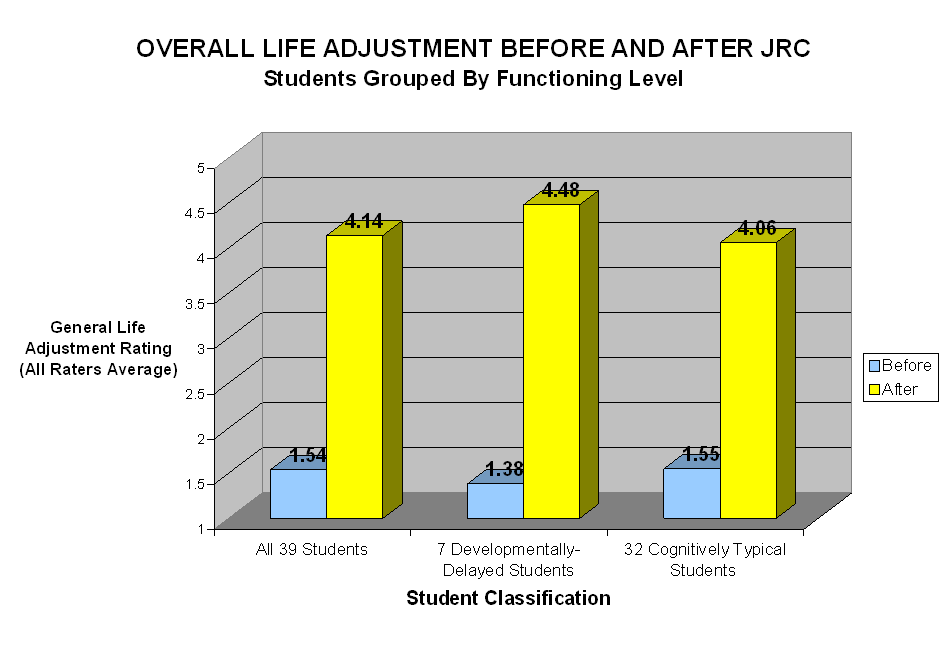
Figure 3.2
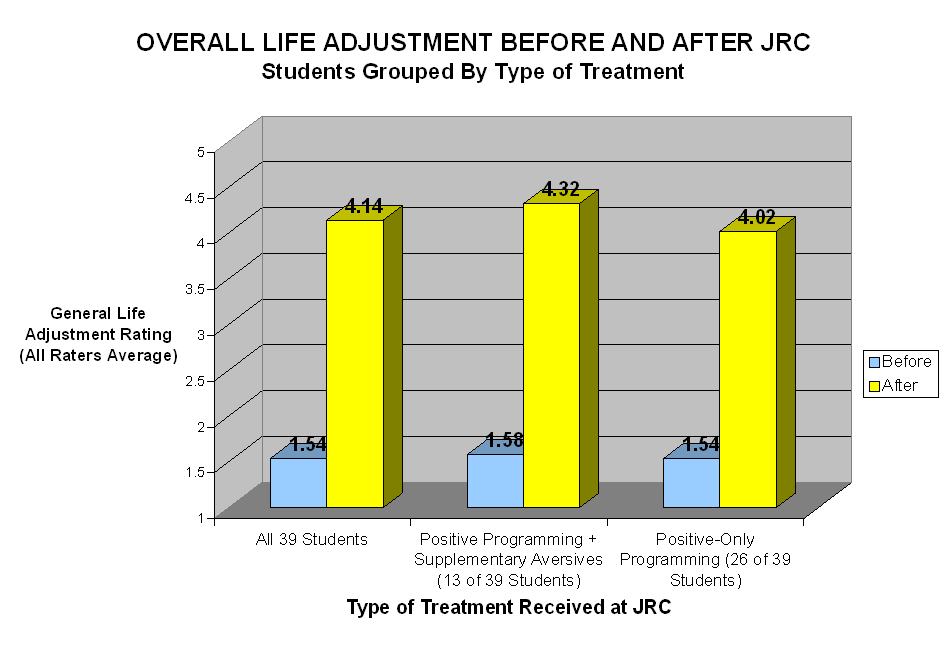
Tables 1.1, 1.2, and 1.3 below (and Figure 3.3) illustrate the differential ratings of guardians, former students, and JRC staff. Overall ratings were quite similar with JRC staff being most conservative in ratings (i.e., providing the lowest ratings both pre- and post-treatment) and former students most optimistic (i.e., providing the highest ratings both pre- and post-treatment).
Table 1.1 Before and After JRC GLA Parent/Guardian Ratings in Different Student Groups
|
|
Groups of Students |
Before JRC |
After JRC |
|
|
All Students (n=33 total participants with data) |
1.6 |
4.05 |
|
Type of Treatment |
Positive-Only Programming (n=22 of 33) |
1.64 |
3.93 |
|
|
Positive Programming + Supplementary Aversives (n=11 of 33) |
1.59 |
4.18 |
|
Level of Functioning |
Developmentally-Delayed (n=7 of 33) |
1.86 |
4.36 |
|
|
Cognitively Typical (n=26 of 33) |
1.56 |
3.96 |
Table 1.2 Before and After JRC GLA Former Student Ratings in Different Student Groups
|
|
Groups of Students |
Before JRC |
After JRC |
|
|
All Students (n=25 total participants with data) |
1.72 |
4.47 |
|
Type of Treatment |
Positive-Only Programming (n=18 of 25) |
1.61 |
4.36 |
|
|
Positive Programming + Supplementary Aversives (n=7 of 25) |
2.00 |
4.75 |
|
Level of Functioning |
Developmentally-Delayed (n=2 of 25) |
1.00 |
5.00 |
|
|
Cognitively Typical (n=23 of 25) |
1.78 |
4.42 |
Table 1.3 Before and After Average JRC GLA JRC Staff Ratings in Different Student Groups
|
|
Groups of Students |
Before JRC |
After JRC |
|
|
All Students (n=39 total participants) |
1.31 |
3.90 |
|
Type of Treatment |
Positive-Only Programming (n=26 of 39) |
1.38 |
3.77 |
|
|
Positive Programming + Supplementary Aversives (n=13 of 39) |
1.15 |
4.04 |
|
Level of Functioning |
Developmentally-Delayed (n=7 of 39) |
1.29 |
4.07 |
|
|
Cognitively Typical (n=32 of 39) |
1.31 |
3.80 |
Figure 3.3
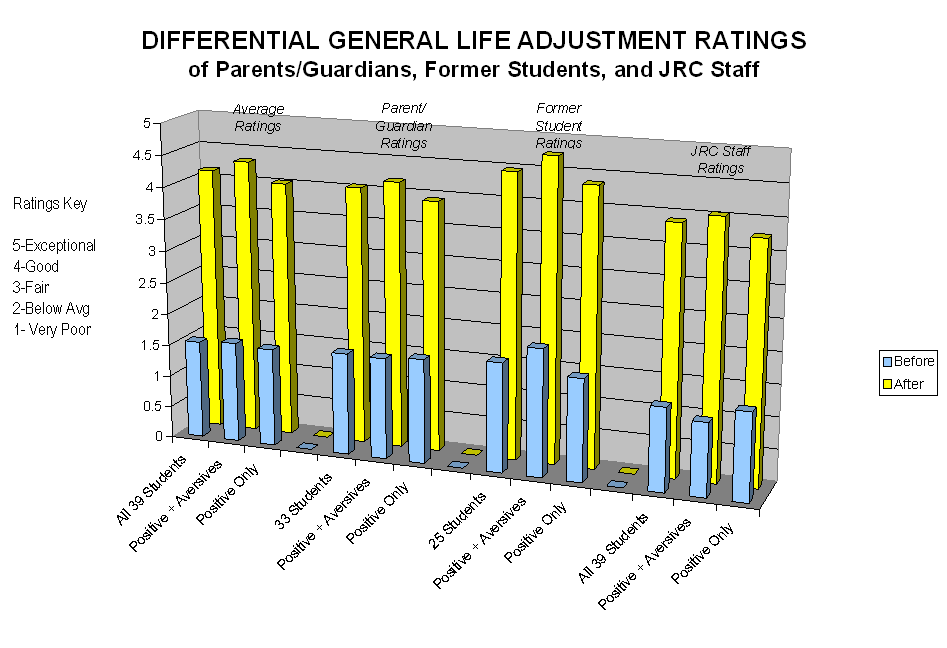
Certain quality of life indicators such as “No Psychiatric Hospitalizations,” “Off Psychotropic Medications,” and “Engaged in Constructive Daytime Activity,” were used for evaluating all of the participants. Other quality of life indicators, such as “Graduated High School/Achieved GED” were used for evaluating Cognitively Typical students only. And still other quality of life indicators, such as “Successful Living in a Group Home” were used for evaluating Developmentally-Delayed students only. For each quality of life indicator, the percentage of the students that showed that indicator before and after enrollment at JRC was calculated. These results are presented in Table 2 below and in Figures 4.1, 4.2, and 4.3.
Table 2. Percentage of Quality of Life Indicators Achieved Before and After JRC
|
Level of Functioning |
Quality of Life Indicator |
Before JRC |
After JRC |
|
All Students[6] |
No Psychiatric Hospitalizations Required |
47.5% |
82.1% |
|
(n=39 total participants) |
Off Psychotropic Medications |
19.4% |
61.5% |
|
|
Engaged in Constructive Daytime Activity[7] |
0.0% |
82.1% |
|
Cognitively Typical Students[8] |
No Court Involvement[9] |
56.5% |
93.8% |
|
(n=32 of 39) |
No Psychiatric Hospitalizations Required |
43.8% |
84.4% |
|
|
Off Psychotropic Medications |
18.8% |
68.8% |
|
|
Engaged in Constructive Daytime Activity |
0.0% |
96.9% |
|
|
Graduated High School/Achieved GED[10] |
3.1% |
21.9% |
|
Developmentally-Delayed Students[11] |
Successful Living In Group Home[12] |
14.3% |
100% |
|
(n=7 of 39) |
Off Psychotropic Medications |
14.3% |
28.6% |
|
|
No Psychiatric Hospitalizations Required |
42.9% |
71.4% |
|
|
Gainfully Employed |
0% |
14.3% |
Figure 4.1
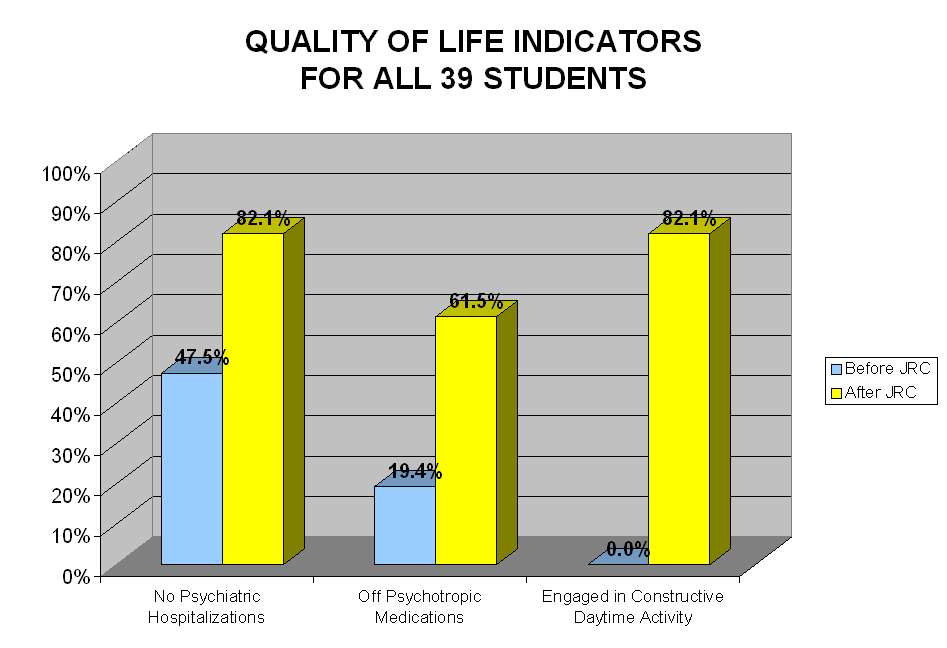
Figure 4.2
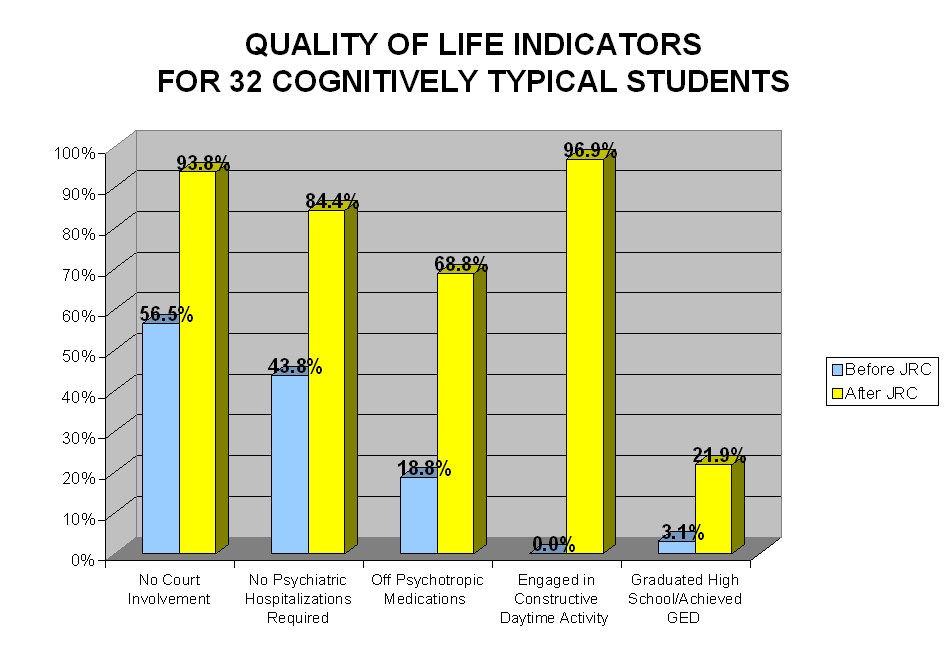
Figure 4.3
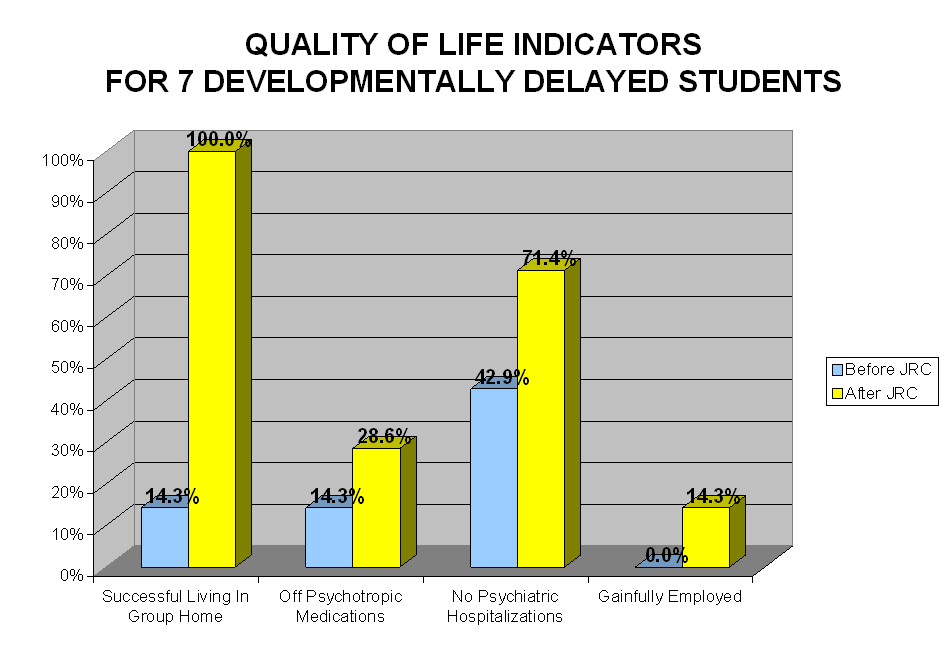
A qualitative sampling of the differences in behaviors and accomplishments (reported by former students, parents, and guardians) before and after treatment at JRC is provided in Appendix A.
Discussion
The results of this investigation indicate that former students of JRC demonstrated marked improvement in their life adjustment and quality of life following treatment. These findings are consistent with last year’s follow-up study. Improvement was apparent for students regardless of their level of functioning (higher- versus lower- functioning levels), the type of treatment they received at JRC (positive programming only versus positive programming with supplementary aversives), or person who completed the ratings (i.e., students themselves, parents or guardians, or JRC staff).
JRC staff members were most conservative in their ratings of participants, which possibly reflects greater objectivity in considering all factors of the former students’ general life adjustment. Self-ratings of former students were most optimistic, suggesting an additional level of subjectivity in the consideration of their own life adjustment. Despite some differences in ratings of general life adjustment between former students, parents or guardians, and JRC staff; all ratings overall were highly similar. Agreement between raters was satisfactory at face value, thus specific figures for inter-rater reliability were not calculated.
The finding that students who received positive programming with supplementary aversives obtained higher general life adjustment ratings than those who received positive programming alone lends preliminary evidence in support of the use of supplementary aversives, as part of a comprehensive behavioral package, when positive programming alone is insufficiently effective. This finding was also consistent with last year’s results, with this year’s study having twice as many participants in the sub-group that received treatment with supplementary aversives.
Limitations of the current study included the small overall sample size and the small sample size of certain subgroups examined (e.g., developmentally-delayed students and those receiving supplementary aversive treatment procedures), although the number of participants in all subgroups increased relative to last year’s investigation. As with last year’s study, the primary reason for these limitations was the inability to locate current contact information for a significant number of the initially selected participants. The ability to successfully contact the guardians of former students remains a significant aspect in assessing the long-term treatment effects of residential programs. Maintaining more frequent on-going contact with guardians of former students as well as former students may increase the ability to track the follow-up progress of more students in the future.
In conclusion, although there were several factors that limited the generalizability and significance of the findings, the results indicate that former students of the Judge Rotenberg Educational Center showed substantial overall improvement as measured by the General Life Adjustment indicator employed. The group as a whole also showed substantial improvement in each of the quality of life indicators chosen for use.
Suggested areas of improvement that might be considered to enhance future follow-up studies of residential care include the following additions: (1) a standardized symptom or behavioral checklist administered at pre-admission, at discharge, and at specified periods post-discharge; (2) a control group consisting of students accepted into the facility, but not attending; (3) an examination of the relationship of pre-admission variables (e.g., number of previous placements, intellectual functioning, and prior adjudication) to post-treatment outcomes; and (4) an examination of the relationship of other variables (such as time since discharge, length of stay, reason for discharge, etc.) to post-treatment outcomes.
Possibly the most important aspect of collecting and examining post-treatment data for residential care is to identify better ways to improve the transitional process and quality of life for former students. To this end, JRC is presently in the process of implementing a Follow-Up Program, which includes the following components:
(1) Periodic telephone calls to the former student, guardians, and day activity agency (e.g., school, day treatment program, Job Corps, etc.) to ascertain status and make suggestions for helpful intervention,
(2) Occasional visits to the student by JRC staff,
(3) On-going email communication with student by JRC teachers and administrators
(4) Behavior contracts for good performance established (and rewards provided) by JRC, present day activity agency, or guardians,
(5) Continued self-management assistance from JRC to promote good performance in post-JRC environments,
(6) Offer of training to personnel involved with student in post-treatment setting,
(7) Invitation to student to contribute information on progress to an online database including: (a) behavior frequency counts collected by student, guardian, or others, and (b) periodic prose reports or comments on student’s progress and status,
(8) Special online discussion board for former students and staff to promote continued communication and support, and
(9) Instituting follow-up support six months prior to discharge to facilitate transition.
Taking these additional steps may assist in maximizing the general life adjustment and quality of life for former students by allowing for minimally restrictive continued treatment efforts, communication, and support through the gradual reduction of components of successful residential care.
Appendix A
Sampling of Behaviors Reported by Former Students, Parents, and Guardians
Before and After Treatment at the Judge Rotenberg Center (JRC)
|
Accomplishments of JRC Students After Treatment
|
Behaviors Reported Before Treatment at JRC |
|
· Achieved Graduation Equivalency Diploma · Graduated with Regents Diploma · Has good relationship with family · Living in own apartment · Married · Raising own children · Working in medical office · Working at printing company · Working as cashier in grocery store · Working as teacher’s aide in private school · Working full time in a bank · Working at a restaurant and a bank · Has three part-time jobs · Active in the community · Planning to attend college · Serving in the military · Served in Iraq as cannoneer · Finished Associate’s Degree · Full scholarship to Wheaton College · Ranks in Top 10 in high school · Participating in a play · Preparing for the Regents Exam · Goes bike riding and bowling · Has welding and drawing as hobbies · Plans to take courses at community college
|
· Mutilates Self · Is truant · Uses illicit drugs · Abuses alcohol · Assaults others · Is incarcerated · Has poor impulse control · Exhibits tantrums · Runs away from home · Is hospitalized in psychiatric facility · Experiences hallucinations · Pulls fire alarms · Lies · Attacked student with razor blade · Is suicidal · Threatens to kill others · Has poor social skills · Highly disruptive in school · Gang involvement · Experiences mood swings · Engages in binge eating · Engages in unprovoked assaults · Is delusional · Is sexually promiscuous · Described as belligerent · Displays violent outbursts · Sets fires · Engages in head banging |
[1] Additional information is available from JRC’s website at www.judgerc.org.
[2] The GED is a remote-controlled skin-shock device which delivers brief, mild electrical stimulation to the surface of the skin. The reader is referred to www.effectivetreatment.org/remote.html for a detailed paper regarding the development and characteristics of the GED. Additionally, a case study documenting the effectiveness of positive programming supplemented with contingent aversives in the form of the GED can be found at www.effectivetreatment.org/treat.html.
[3] 5-point Likert-type scale (1-very poor, 2-below average/not good, 3-fair, 4-good, 5-exceptional)
[4] See Figure 3.2
[5] See Figure 3.1
[6] See Figure 4.1
[7] Defined as gainfully employed in the community, attending school, taking academic or vocational classes, military, etc.
[8] See Figure 4.2
[9] Defined as any court involvement including adjudications, petitions filed such as PINS (Person In Need of Supervision or CHINS (Child In Need of Supervision).
[10] Graduation Equivalency Diploma
[11] See Figure 4.3
[12] Those not living in a group home required a more restrictive setting such as a psychiatric hospital or had been expelled from a group home.